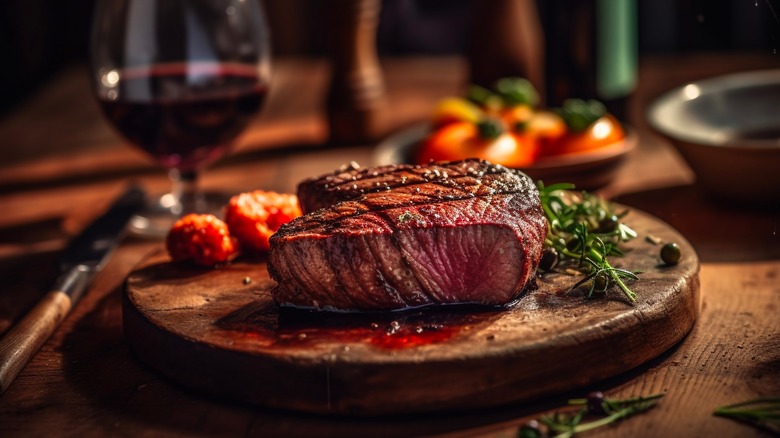The Types Of Meat You Shouldn't Bother Injecting With Marinade
As BBQ aficionados know, meat injectors can add a dose of flavor to your cuts, ensuring a good balance of flavor throughout. When you inject a cut of meat, you're adding moisture and flavor deep into the meat. It allows those seasonings and sauces to reach deeper than if you were just marinating the meat. Marinating the meat just reaches the surface levels of the meat, meaning it doesn't strike into the tissue making for a blander meal. Additionally, injecting meats with marinades is a good way to tenderize them. Salt helps break down the meat from within, also helping it to hold its juices.
So by that logic, it's always better to inject your meat instead of marinating it then, right? You're probably wondering if you've been doing it wrong marinating those steak cuts or chicken legs all your life. Well, no using a meat injector isn't always better. You really should only use a meat injector if you're dealing with a thicker cut of meat because it allows the juices to reach places they otherwise wouldn't.
When it comes to thinner cuts of meat, you should put away that meat injector as it makes for a poor replacement for marinating the meat. The fluid injected into thinner cuts doesn't absorb and ends up leaving the meat before it can make a difference.
When to put the meat injector aside
When using a meat injector, think of large cuts of meat and roasts. While that T-bone or porterhouse may be thick by steak standards, you shouldn't break out the meat injector. In some circles of steak aficionados, that can be seen as blasphemy. One home cook responded on a forum about steaks, "That would be a big negative" to using a meat injector on a steak. Instead, let your steak soak overnight in a marinade of juices and then season with salt and pepper for the best quality.
Instead, when it comes to beef, meat injectors work best with briskets or pot roasts, larger chunks of meat. Injecting these roasts allows the juices to penetrate the center and spread throughout. You don't have to worry about the liquid dripping out prior to cooking. Consider the same types of cut when deciding over the meat injector for pork as well — big thick hearty cuts of pork butt, pork shoulders, or even a whole pig. If you're dealing with something sliced like pork chops, then just toss it in a marinade.
When it comes to poultry, you should only use a meat injector if you're cooking a whole chicken or turkey. If you're grilling or frying up individual pieces, it's better to brine or marinate them in a sauce.
Tips and tricks for injecting with marinade
At the surface level, using a meat injector is as simple as filling a metal syringe with marinade and stabbing a piece of meat. However, as the above shows, there's a certain art to mastering the culinary practice, and it can be easy to mess up if you don't know what you're doing. Not only is it important to use the right cuts of meat, but you will also want to be strategic with your injection spots.
To ensure that your marinade is thoroughly and evenly spread throughout your meat, you should spread your injections across the piece of meat with multiple entry points. This allows the marinade to fill every ounce of the meat. Just be careful not to go overboard. Use a small amount of marinade for each injection spot. When it comes to using a meat injector, you will want to make sure that your needle properly pierces the flesh. If you're injecting a bone-in cut, press until you feel the needle press against the bone.
When choosing a needle size, consider one that's long enough to properly pierce the meat. Likewise, you want to make sure that your marinade isn't too thick or it will clog the needle. Follow these tips, and your cuts will be the talk of the town. Just remember when to use the injector.


